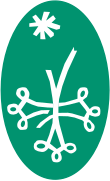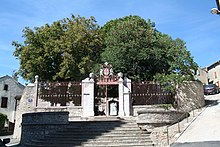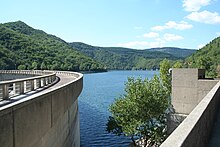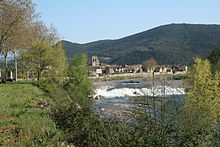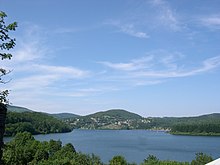Haut-Languedoc Regional Nature Park
The Haut-Languedoc Regional Nature Park ( French: Parc naturel régional du Haut-Languedoc ) extends into the French departments of Hérault and Tarn in the Occitanie region . It is located in the Haut-Languedoc landscape of the same name, roughly between the towns
- Castres in the northwest,
- Revel in the west,
- Saint-Chinian in the southeast and
- Bédarieux in the east.
In the northeast it borders directly on the Grands Causses Regional Nature Park .
Park management
The nature park was founded on October 22, 1973 and today covers an area of around 306,000 hectares. The park administration is based in Saint-Pons-de-Thomières ( 43 ° 29 ′ 27 ″ N , 2 ° 45 ′ 38 ″ E, ), where the "Maison du Parc" is located. Following the revision of the charter in 2012, 109 municipalities with a catchment area of around 100,000 residents now form the park.
Larger places in the park
|
Tarn department: |
Department of Herault: |
landscape
The nature park includes the southern foothills of the French massif Central . The valleys of the rivers Agout , Thoré and Orb structure the park area mainly in an east-west direction. From a geological point of view, the area lies in the center of a Variscan orogeny , which took place more than 300 million years ago and whose relics now run from northeast to southwest through the Regional Nature Park and are the cause of the occurrence of granite, gneiss and mica schist , as well as locally Represents sandstone and hard coal deposits. Due to its complex geological structure and the location in the overlap area between the Atlantic and Mediterranean climatic zones, diverse landscape forms have developed.
The park includes the following natural landscapes and biotopes :
- Sidobre
- Monts de Lacaune
- Montagne de l'Espinouse and the Caroux massif
- Monts d'Orb
- Plateau des Lacs
- Montagne Noire
- Vignes et Vallées
Sidobre
The Sidobre is a granite plateau in the northwest part of the Haut-Languedoc Regional Nature Park, the main towns are Burlats , Lacrouzette , Montredon-Labessonnié and Roquecourbe . The river Agout winds around the northern and eastern edges of the approx. 10 km long and approx. 10 km wide area, the surface of which is severely fissured due to erosion . It is one of the largest granite deposits in Europe; bizarre granite blocks were formed by the erosion, which represent a special tourist attraction in certain places.
Monts de Lacaune
The Monts de Lacaune is the name given to the landscape around the chain of hills of the same name in the northern part of the nature park. It is bounded to the south by the Agout River and its tributary Vèbre . The main towns in this area are Lacaune and Viane . The highest peak of the mountain range is the Montgrand (1,267 m), but it is not open to the public because there are important military installations in its immediate vicinity. Nearby is the Roc de Montalet (1,259 m), on which a small statue of Mary is enthroned.
Montagne de l'Espinouse and the Caroux massif
This landscape includes the two connected mountain ranges Montagne de l'Espinouse and Caroux . It is located in the eastern part of the Regional Nature Park and is bounded in the north by the River Agout and in the south by the Orb . The main town is Saint-Gervais-sur-Mare . The impressive George d'Héric Gorge runs north between the two massifs .
Monts d'Orb
The area is located in the east and extreme northeast of the nature park. It is named after the Orb River , which crosses the area in its upper reaches. In the northeast section, which extends far into the Grands Causses Regional Nature Park , the river is dammed into the Réservoir d'Avène reservoir , and a little further south it crosses the Forêt Domaniale des Monts d'Orb . Below Bédarieux , the river swings south-west to west. The main towns in the Monts d'Orb are Avène , Bédarieux, Le Bousquet-d'Orb , Hérépian , Lamalou-les-Bains , La Tour-sur-Orb and Villemagne-l'Argentière . While coal was mined here in the past, the landscape is now known for its thermal springs (Avène, Lamalou-les-Bains).
Plateau des Lacs
In the center of the nature park there is an area rich in lakes, which was created by the damming of some important rivers. They are:
- Lac des Saints-Peyres , southeast of Anglès , reservoir of the Arn River
- Lac de la Raviège , west of La Salvetat-sur-Agout , reservoir of the Agout river
- Lac du Laouzas , northeast of La Salvetat-sur-Agout, reservoir of the Vèbre river
Montagne Noire
The Montagne Noire landscape is located in the south-western part of the nature park. Within the park boundaries, however, only the heavily forested northern slope of the ridge and the wide valley furrow of the Thoré river , which is relatively heavily industrialized. The main towns are: Dourgne , Labrugière , Mazamet and Saint-Amans-Soult . The Montagne Noire are a very spring-rich landscape, many of the source streams leading to the south were derived for the irrigation of the Canal du Midi canal . The highest point is the Pic de Nore summit (1,211 m).
Vignes et Vallées
The name means vineyards and valleys in German and describes the area in the southeast of the nature park very clearly. It is the slow transition from the Montagne Noire to the Minervois and the lowlands of the Aude Valley. Numerous rivers and streams strive south to south-east, including the Orb, and their valley furrows open up access to the Mediterranean climate, which means that viticulture can already be practiced here along the rivers , which are included in the wine-growing regions of Minervois , Saint-Chinian and Faugères . The main towns are: Saint-Pons-de-Thomières , Olargues , as well as many small wine towns such as Minerve , Saint-Jean-de-Minervois , Roquebrun and Vieussan .
fauna and Flora
The Haut-Languedoc Regional Nature Park has a great variety of natural influences: The Mediterranean zone is a landscape formed by heat and drought with few rainy episodes. This enables a remarkable flora and fauna to exist. You can find downy oaks , garigue and maquis as ground cover. The holm oak also develops here in special locations, such as on peaks, on ridges or in gorges.
The zone shaped by the Atlantic climate is a landscape with larger elevations. It has a lush green and forms the basis of life for numerous tree species, such as the common beech , the oak and several types of conifers , such as the Douglas fir , which were introduced by human hands. You can also find areas used for agriculture, as well as grassland and heathland . Also peat bogs are common and offer the drought a supply of green fodder .
The territory of the natural park is home to about 250 species of birds , 120 of which regularly nest here, and 26 species of bats . 170 animal species are classified as remarkable, a large part is protected on the national and European level. Some of them have become emblematic of the Upper Languedoc :
- Bonelli's eagle
- Little owl
- Red-headed shrike
- Long-footed bat
- Kleinspot genet
- Otter
- Trout
- Jackdaw crab
- River pearl mussel
In the area of the Caroux massif, a herd of mouflons , originally imported from Corsica , has also settled.
The flora includes around 2500 species of flowering plants, many of which are endemic and under special protection. Sundew , golden leek , carnation and black cumin are among the rarest representatives .
